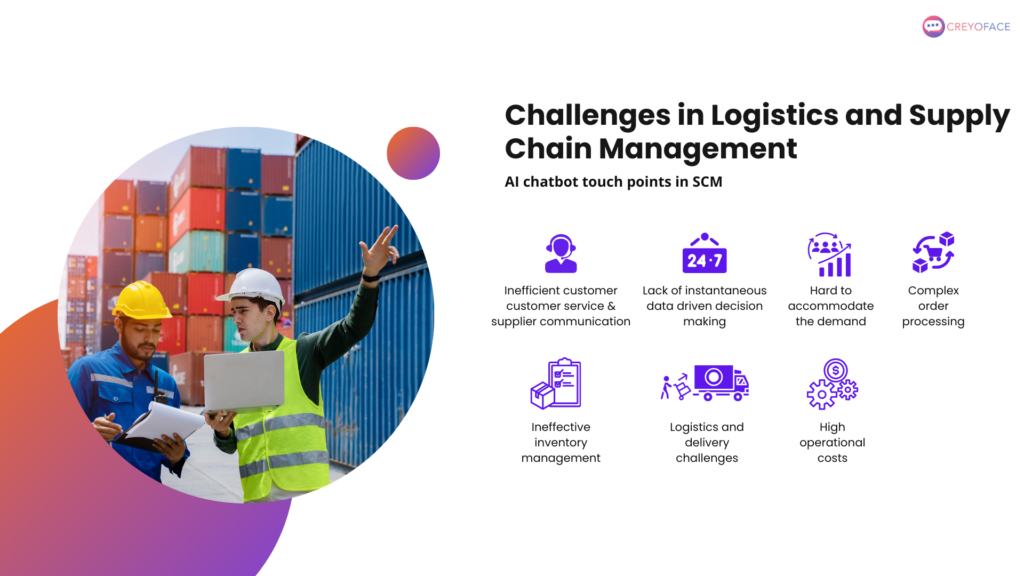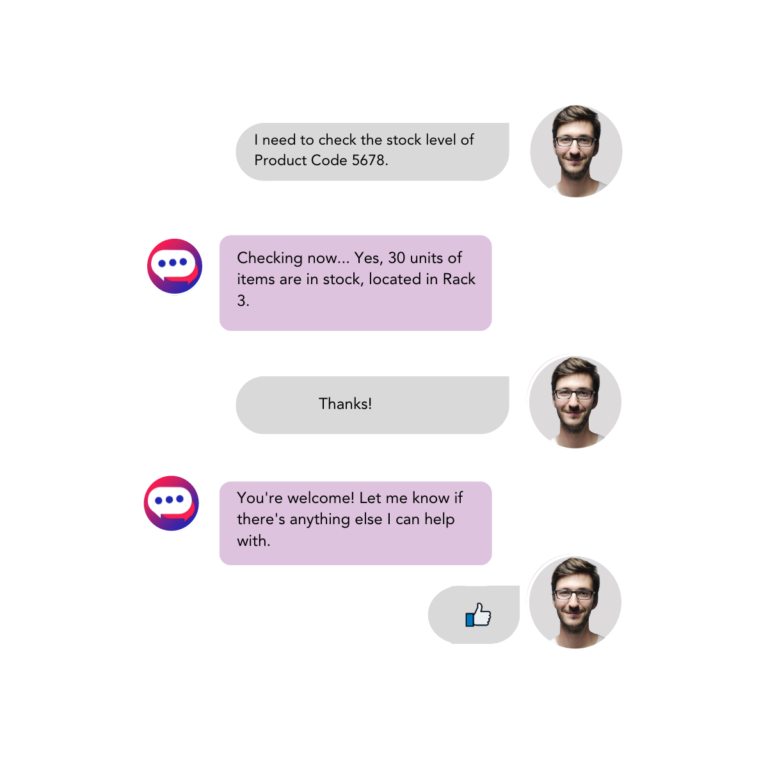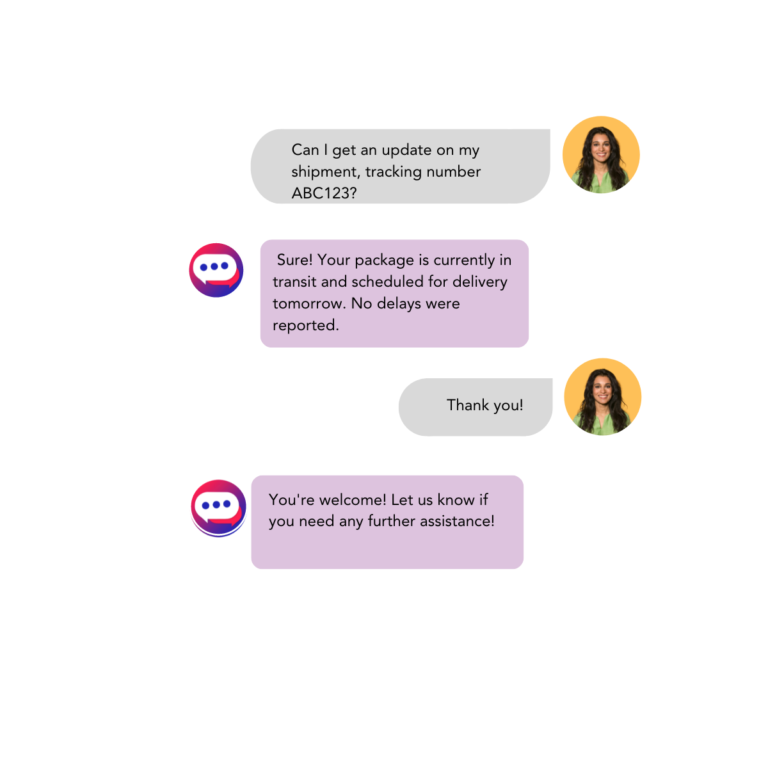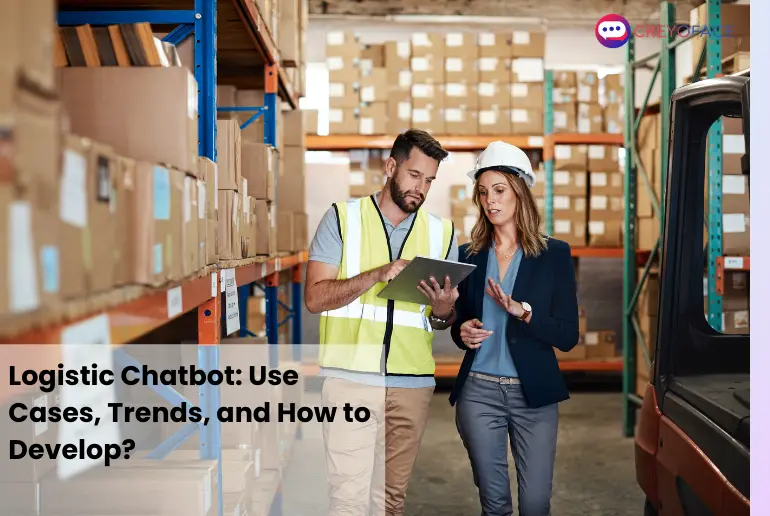Are you Looking to streamline your logistics operations? A logistics chatbot is your solution! These bots are designed to tackle inquiries and manage tasks efficiently. Curious about the transformation they can bring to your logistics workflow? Let’s dive in and discover the impact of logistic chatbots on your business.
Introduction
Did you know that chatbots make a big difference in the logistics industry? Logistics is all about getting things from where they’re made to where they need to be quickly and without spending too much. It can be tricky because there’s so much information to keep track of.
Chatbots, which you have seen in customer service, are also helping out in logistics. They connect different systems, give quick information, help people talk to each other, and are always there to help.
In this blog, we’ll see how logistic chatbots do more than answer questions. They’re making the whole process smoother and helping logistics companies work better with technology.
Prominent Challenges Logistic Chatbots Can Solve
Speed and accuracy are essential in logistics, and logistic chatbots play a significant role in improving these areas. These AI-powered tools act as valuable team members, tackling critical tasks in managing the flow of goods.
They help in various ways, like keeping track of numerous products, ensuring customers receive prompt and clear responses, and figuring out the best ways to deliver packages. Moreover, logistic chatbots are particularly useful for handling several tasks simultaneously, such as quickly processing orders and finding efficient delivery routes.
Let’s explore some prominent challenges that a logistics chatbot can solve.

Inefficient Customer Service & Supplier Automation
Traditionally, interactions in logistics involve manual processes, leading to delays and errors. Chatbots revolutionize this by providing instant responses to customer queries and automating supplier communications, streamlining the entire supply chain process.
Lack of Instantaneous Data-Driven Decision Making
Logistics operations often generate vast amounts of data, but manual analysis could be faster. Chatbots can rapidly analyze data, offering real-time insights and enabling swift, data-driven decisions, enhancing the agility of the supply chain.
Hard to Accommodate the Demand
Predicting and adjusting to fluctuating demand is challenging. Chatbots use predictive analytics to forecast demand more accurately, helping businesses adjust inventory and logistics operations ensuring optimal stock levels.
Complex Order Processing
Order processing in logistics is often prone to human error. Logistic chatbots automate and streamline this process, reducing errors, speeding up the process, and improving customer satisfaction.
Ineffective Inventory Management
Manual inventory management can lead to inaccuracies. Chatbots offer real-time tracking and management, providing alerts for low stock and automating reordering processes, leading to more accurate inventory control.
Logistics and Delivery Challenges
Optimizing delivery routes and schedules can be complex. Chatbots assist in planning and optimizing routes, considering real-time variables, and providing customers with up-to-date delivery information.
High Operational Costs
Manual processes in logistics lead to increased labor costs. Chatbots automate routine tasks, optimize operations, and reduce errors, significantly cutting costs and enhancing efficiency.
Exploring the Logistic Value Chain: Potential Chatbot Integration Areas
Logistics focuses on efficiently moving products, ensuring they reach customers from manufacturers. You might wonder how chatbots fit into this process. Let’s take a look at the steps in this process first. Then, we can talk about how chatbots could be helpful at each step.
Warehouse Management
Warehouses are central to logistics, serving as storage hubs. The primary goal is efficient inventory management, akin to organizing a complex puzzle.
It means ensuring every item is in the right spot, easy to find, and safe. Good warehouse management is about managing things well, getting to them quickly, and keeping them safe.
Order Processing & Fulfillment
This stage is the core of logistics, where customer orders transition from digital requests to physical deliveries. Precision is paramount here – accurate item selection, secure packaging, and prompt shipping.
It’s about maintaining accuracy and speed throughout the process, from order initiation to delivery.
Freight Management
Moving goods efficiently is the essence of freight management. It involves strategic route planning to achieve the most cost-effective and timely transportation.
Moreover, it’s akin to solving a complex puzzle, balancing time, cost, and safety to ensure seamless product movement from origin to destination.
Customer Service & After-Sales Support
This stage post-purchase is crucial for customer satisfaction. It entails keeping customers informed and addressing their needs.
Whether answering inquiries, resolving issues, or managing returns, effective customer service aims to provide a positive post-purchase experience, fostering trust and loyalty.
Returns Management & Reverse Logistics
Sometimes, products need to be returned to their origin. This stage handles the return process efficiently, encompassing the physical return and subsequent actions like repair, recycling, or responsible disposal of products.
Feedback & Continuous Improvement
Lastly, this phase focuses on refining and optimizing the entire logistics process. It involves gathering feedback and implementing improvements, akin to fine-tuning a machine. This continuous enhancement ensures a smoother, more efficient logistics operation that can adapt to evolving demands and challenges.
Use Cases of Logistc Chatbots
Logistic chatbots are revolutionizing the logistics sector by offering efficient and user-friendly services. We’ve explored the various functions of logistics companies through the logistics value chain. Now, let’s examine how AI chatbots for logistics can efficiently execute these functions.
Warehouse Management
Chatbots can significantly aid in management in a busy warehouse, which is a vital part of a logistics operation. Let’s explore use cases of logistic chatbots in warehouse management.
Inventory Queries & Updates
Chatbots can significantly streamline inventory management by providing real-time updates. They can quickly respond to queries regarding stock levels, locations, and status updates, helping staff locate items efficiently.
Moreover,it reduces time spent on manual checks and searching for items, enhancing overall productivity. Have a look at below example.

Order Picking Assistance
AI chatbots can guide warehouse employees through optimized picking routes. Also, they can suggest the quickest paths for order picking by analyzing the layout and current inventory status.
It reduces the time to fulfill orders and minimizes errors, ensuring that the right products are selected for shipment.
Incident Reporting
Chatbots can be a reporting tool for any incidents or discrepancies in the warehouse, such as damaged goods or system errors. They can record details of the incident, notify relevant personnel, and track the resolution process.
Furthermore, it ensures issues are addressed promptly and efficiently, maintaining warehouse operations’ integrity.
Safety Compliance
Maintaining safety compliance is critical in warehouse operations. Chatbots can provide workers with reminders and guidelines on safety protocols. They can also conduct safety quizzes, track compliance rates, and report protocol breaches, helping maintain a safe working environment.
Equipment Handling
Proper management of warehouse equipment, such as forklifts, pallet jacks, and conveyor belts, is essential. Chatbots can facilitate this by scheduling regular maintenance and training sessions for staff.
Moreover, they can send reminders when equipment needs servicing, track maintenance logs, and even assist in booking training sessions, ensuring that all equipment is handled correctly and safely.
Order Processing and Fulfillment
Logistic chatbots make handling and delivering orders much easier and faster. They help quickly process orders from when they are received until they are sent out for delivery.
Also, it makes things more efficient in busy warehouses, ensuring orders are handled correctly and sent out on time.
Personalized Order Updates
Logistic chatbots can provide customers with updates on their orders in real-time. For instance, they can notify
customers when their order is processed, packed, or out for delivery and when it’s expected to arrive.
It means customers stay informed and can plan accordingly for the arrival of their goods.
Handling Order Modifications
If a customer needs to change their order, such as adjusting the size, color, or quantity, a chatbot can process these modifications quickly. This flexibility enhances customer satisfaction, as they don’t have to navigate a complex process or wait to speak with a customer service representative to make simple changes. Here is an example.

Address Verification & Correction
A chatbot can confirm the shipping address with the customer to ensure accuracy before shipping an order.
Moreover, if there are any mistakes, the chatbot can correct them quickly, reducing the chances of delivery errors and the associated costs of resending or rerouting packages.
FAQs and Information Provision
Chatbots can answer common questions customers might have about their orders. It could include queries about shipping methods, delivery times, packaging options, etc.
Also, chatbots can reduce the workload on customer service teams and improve the overall customer experience by providing instant responses.
Expedite Requests Handling
Sometimes, customers need their orders delivered faster than initially planned. Chatbots can manage these urgent requests by offering different shipping options and providing immediate cost estimates for expedited delivery.
Multi-Channel Order Integration
Chatbots can sync orders across various sales channels, ensuring customer service is consistent whether the customer shops online, via mobile, or through another sales platform.
Moreover, this integration is crucial for a unified customer experience and helps prevent errors in order processing.
Freight Management
Logistic chatbots are changing how freight management works, making it faster and more accurate. They help track shipments, find the best delivery routes, communicate with carriers, handle paperwork, and answer customer questions. Let’s explore more.
Shipment Tracking
An AI chatbot in this role would act as a real-time tracking agent. It keeps the logistics team and the customer updated on the shipment’s journey. Such a chatbot could provide notifications on critical milestones:
- When an item is dispatched.
- When it reaches a sorting facility.
If it’s delayed. - When it’s out for delivery.
It reduces the need for manual tracking and provides a more interactive and informed experience for the customer. The image below is an example of a logistics chatbot providing shipment information.

Route Optimization
Ensuring that delivery routes are as efficient as possible is important in logistics. A chatbot with route optimization capabilities can assist drivers by suggesting the best routes that save time and reduce fuel consumption.
Also, this logistic chatbot would consider traffic conditions, distance, and delivery windows to provide dynamic routing advice.
Carrier Communication
This chatbot would be a communication hub between the logistics team and carriers. It would help manage and distribute information regarding the status of shipments, carrier availability, and load allocation. Doing so would streamline the process of assigning shipments to carriers, thus improving efficiency and reducing the potential for human error.
Documentation Assistance
In logistics, paperwork is a necessary aspect that can often be complex and time-consuming. A logistic chatbot could help generate, sort, and manage the required shipping documents, ensuring compliance with international shipping regulations and customs requirements.
Moreover, it would also aid in reducing delays and errors associated with manual document handling.
Customer Queries
Customer service is a crucial part of logistics, and a chatbot here would serve as the first point of contact for customer inquiries. It could answer common questions about shipping times, costs, and procedures, providing a quick and seamless service experience.
Moreover, if the query is too complex for the chatbot, it could reroute the customer to a human agent who can handle specific concerns.
Customer Service and After-sales
In customer service and after-sales, chatbots are helpful. They quickly answer customer questions, solve problems, explain warranty and service details, collect feedback, and guide customers through returns and exchanges.
Instant Response to Customer Queries
A chatbot serves as a readily available consultant for any logistical inquiries. It is programmed to provide prompt and accurate responses to common questions regarding product deliveries, service timelines, or company policies, thereby enhancing the efficiency of customer service operations.
Issue Resolution & Support
When faced with logistical complications, the chatbot acts as a virtual troubleshooter. It assists in identifying and resolving prevalent concerns, offering a step-by-step guide to navigate the resolution process, thus facilitating a smoother customer experience.
Warranty and Service Information
The chatbot functions as an informative source regarding warranty conditions and service options. Moreover, it adeptly manages warranty claims and furnishes customers with essential details to arrange repair or maintenance services, ensuring that the products’ integrity and trust are maintained.

Feedback Collection
Post-transaction, the chatbot undertakes the role of an evaluator, soliciting customer feedback. This essential activity assists in gauging customer satisfaction and pinpointing opportunities for service enhancement, thereby contributing to the continuous improvement of service quality.
Return and Exchange Management
In the event of product returns or exchanges, the chatbot emerges as a guide, providing comprehensive instructions based on the company’s policies. It simplifies the process by offering clear information on the procedural steps, ensuring a hassle-free customer experience in managing post-purchase modifications.
Returns management & Reverse Logistics
In managing returns and reverse logistics, chatbots are super helpful. They help customers return products quickly, arrange pickups, keep track of the return status, get feedback, and sort out why items are returned. This makes things simpler and faster for both the customers and the logistics team.
Guided Return Process
A chatbot can be a virtual guide for customers looking to return a product. It explains the steps of the return process in a clear, easy-to-follow manner, clarifying the policies and procedures they must adhere to.
Moreover, the chatbot ensures that customers understand the conditions for returns, such as the state the product must be in and the time frame for eligible returns, making the process transparent and customer-friendly.
Logistics Chtabots Schedule Pickups
In reverse logistics, returning goods to the seller or manufacturer is just as necessary as the initial delivery. Moreover, a chatbot can assist customers in scheduling the pickup of items they wish to return and coordinating with logistics providers to arrange for timely collection.
Also, this involves selecting a convenient pickup time and location and providing instructions for the logistics provider.

Status Updates and Tracking
Once a return is initiated, customers want to know the status of their item and when they can expect a refund or exchange. A chatbot can keep them updated in real-time, tracking the return from when it leaves the customer’s hands to when it is returned to the warehouse or retailer.
Also, this kind of tracking reassures customers that their return is being handled properly.
Feedback Collection
Understanding why customers return items is vital for any business. A chatbot can collect feedback and reasons for returns directly from customers. This information is invaluable, providing insights that can improve product quality, packaging, shipping methods, and more, potentially reducing the rate of future returns.
Return Reason Classification
A logistics chatbot can automatically classify the reasons for returns, sorting them into categories like size issues, defects, or customer preferences.
Moreover, this classification helps decide the next steps more efficiently, such as whether the product should be restocked, repaired, or discarded. Automating this process saves time and resources and can help logistics teams manage returns more effectively.
Feedback and Continuous Improvement
Logistic chatbots help get feedback and make things better over time. They collect opinions automatically, figure out what they mean, keep an eye on how well things are going, and even suggest new ideas for improvement.
Moreover, it makes it easier for logistics companies to understand what needs to be fixed and to keep getting better at what they do.
Automated Feedback Collection
Chatbots can be programmed to collect feedback across various touchpoints in the logistics chain. It includes gathering insights from surveys, social media interactions, and feedback forms embedded in delivery confirmation emails or the logistics service provider’s website.
Also, by automating this process, a chatbot can help compile a vast amount of data without manual intervention, saving time and resources while enhancing the accuracy of the collected feedback. Have a look at below example.

Data Analysis and Insights
The collected feedback is a gold mine of information that a chatbot can analyze to identify trends and patterns. In logistics, this might involve understanding common delivery issues, identifying bottlenecks in the supply chain, or recognizing exemplary performance in certain areas.
Also, by analyzing feedback data, a chatbot can provide actionable insights that help logistics companies focus their improvement efforts where they are most needed.
Performance Monitoring
Chatbots can monitor key performance indicators (KPIs) such as delivery times, customer satisfaction scores, or incident reports. They can alert management to any deviations from the set targets or standards.
Furthermore, this real-time monitoring ensures logistics companies can quickly respond to performance dips and maintain service quality.
Suggestion and Idea Gathering
Encouraging a culture of continuous improvement is vital in logistics, where processes must constantly evolve to become more efficient.
Also, chatbots can facilitate the collection of suggestions for improvements from employees and customers. These suggestions can then be fed into innovation pipelines to improve logistics operations.
Proactive Suggestions
Chatbots can also proactively suggest improvements based on feedback and performance data analysis. For example, if customers frequently report delays in a specific region, the chatbot can highlight this pattern and suggest reviewing the delivery routes or carrier partnerships in that area.
Also, by proactively identifying and addressing issues, chatbots can help logistics companies stay ahead of potential problems.
Emerging Trends in Logistic Chatbot Development
Logistic chatbots represent a significant technological advancement reshaping how companies manage their supply chains, interact with customers, and streamline operations.
As e-commerce transactions grow, logistics companies are turning to AI chatbots to handle the increasing demand for efficient and responsive supply chain management.
Here are some of the emerging trends in logistic chatbot development that are setting the stage for the future of this industry.
Convergence of IoT and Chatbots
Chatbots will integrate with IoT to offer a real-time operational view. For instance, a chatbot could receive data from GPS and weather sensors to optimize delivery routes, adjusting in real-time for delays or early arrivals and providing updates directly to customers and logistic managers.
Enhanced Voice and Speech Recognition
Future chatbots will interpret voice commands accurately, filtering out background noise. In a warehouse, for instance, a worker could ask a chatbot where to store incoming inventory, and the chatbot would provide the optimal location based on current space utilization and inventory levels.
Multimodal Interaction Capabilities
Multimodal chatbots will interact through various inputs and outputs, like touch screens, voice, and visual displays. A chatbot could guide a user through a complex customs documentation process, displaying forms on a screen while explaining steps through voice.
Blockchain-Integrated Security
Blockchain will enhance the security of logistic chatbot communications, creating an audit trail for each transaction and interaction. It would be crucial in scenarios where chatbots facilitate transactions, ensuring data integrity and compliance with regulations.
Integration with Autonomous Vehicles
As autonomous vehicles become more prevalent in logistics, chatbots will serve as the interface for monitoring and managing these assets. Moreover, they could dispatch drones for small deliveries or autonomous trucks for larger shipments, coordinating with IoT systems to track progress and optimize delivery networks.
How to Develop a Logistic Chatbot
A logistics chatbot is essential for businesses seeking an efficient and intelligent operations assistant.
Creyoface helps you to build logostic chatbots in steps.
- Sign up with Creyoface and select a chatbot template that suits your needs.
- Build your chatbot’s workflow easily using our intuitive drag-and-drop widgets.
- Enhance your chatbot’s conversation abilities using our tools for contextual understanding and FAQ training.
- Tailor your chatbot’s appearance to match your brand’s unique style.
- Launch your chatbot on multiple platforms to reach a wider audience.
To know more about creating a logistic chatbot without coding, please refer to our blog How to create an AI chatbot for free without coding?
Conclusion
Today, streamlining operations for both customers and businesses is essential in logistics, and for this purpose, we turn to logistic chatbots. Let’s summarize the key points we’ve discussed in this blog.
- Logistic chatbots are transforming the logistics industry by streamlining operations and improving customer service.
- Chatbots address issues like inefficient customer service, lack of data-driven decision-making, complex order processing, inventory management challenges, and high operational costs.
- Chatbots contribute at every stage of the logistics process, including warehouse management, order processing, freight management, customer service, returns management, and continuous improvement.
- Future trends in logistic chatbot development include integrating IoT, enhanced voice recognition, multimodal interactions, blockchain for security, and coordination with autonomous vehicles.
- Development of Logistic Chatbot is simple using Creyoface no code chatbot builder.
Ready to Start. Sign in to Creyoface to develop your logistic chatbots.
Ready To Explore?
Frequently Asked Questions?
Logistic chatbots are AI-powered virtual assistants designed to help manage and streamline various logistics operations, such as inventory tracking, shipment monitoring, and customer service inquiries.
How do logistic chatbots improve efficiency?
How do logistic chatbots improve efficiency?
They automate routine tasks, provide real-time tracking and updates, facilitate quicker communication, and can predict logistical issues, thereby saving time and reducing manual errors.
Can they integrate with existing logistic management systems?
Yes,logistic chatbots can be integrated with systems such as warehouse management systems and transportation management software for seamless operations.








